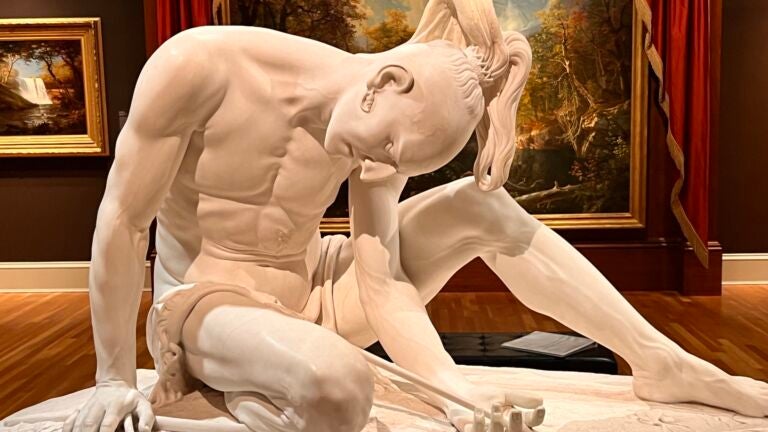Arts
Known simply as “The Wounded Indian,” the statue was sculpted from a single block of white Vermont marble by Peter Stephenson, who completed the work in 1850.

A poignant life-size statue of a wounded American Indian, long the subject of a tug of war between a Virginia museum named for Walter P. Chrysler and a Boston organization founded by Paul Revere, will be sent back to Boston in the wake of an investigation by the FBI, the Boston group said Wednesday.
Known simply as “The Wounded Indian,” the statue was sculpted from a single block of white Vermont marble by Peter Stephenson, who completed the work in 1850. It is described by the group reclaiming it, the Massachusetts Charitable Mechanic Association, as “among the most beautiful and affecting works of American neoclassical sculpture.”
Officials with the association, founded in 1795 by Revere to offer vocational training to poor students and citizens and now based in Quincy, Massachusetts, said it was given the statue by a donor in 1893 and had displayed it for 65 years in its massive, castle-like civic center in Boston.
In 1958, facing financial trouble, the association sold that 300,000-square-foot property, which was filled with artifacts, paintings and other objects. “During the chaos of moving,” said Greg Werkheiser, a lawyer for the association, “MCMA officials were told that the ‘Indian’ had been destroyed.”
The association believed that claim until 1999, when it realized the statue was on display as a major exhibit at the Chrysler Museum of Art in Norfolk, Virginia. When its ownership was challenged at the time by the association, Werkheiser said, the museum insisted it had bought the statue in 1986 from a New York collector and dealer. They said the seller had told museum curators that the statue had been abandoned and was his rightful property.
The association then embarked on a decadeslong effort to convince the museum that it had never relinquished ownership of the statue and that it was in fact stolen property. The museum eventually agreed to engage in private negotiations with Werkheiser and Paul Revere III, the association’s general counsel.
“‘The Wounded Indian’ is as Boston a piece of art as anything can be,” Revere, a descendant of the Revolutionary hero, said in a statement. “The people of Boston deserve to be able to visit and appreciate this part of their heritage.”
The parties remained at loggerheads until recent months, when the association began applying pressure on the museum by contacting The Washington Post, which wrote about the dispute, and the FBI’s Art Crime Team, which began an investigation this year.
The museum soon agreed to hand back the sculpture, which will return to Boston by the end of August, Werkheiser said. He said shipment costs will likely be about $30,000.
In a statement, Erik H. Neil, the director of the Chrysler Museum, said he “is pleased with the amicable resolution.” For its part, the association complimented the museum for showing “wisdom and collaboration in reaching an amicable and ethical resolution of this matter.”
The FBI said in a statement that it was “proud to have been able to help facilitate the return of this 19th-century statue to its rightful owner.”
Werkheiser, a cultural property lawyer, likened the recovery of the Boston statue to efforts by foreign countries to reclaim relics from museums. “This highly visible return after so many decades,” he said, should show other institutions “that it’s rarely too late to correct a historic wrong.”
This article originally appeared in The New York Times.







